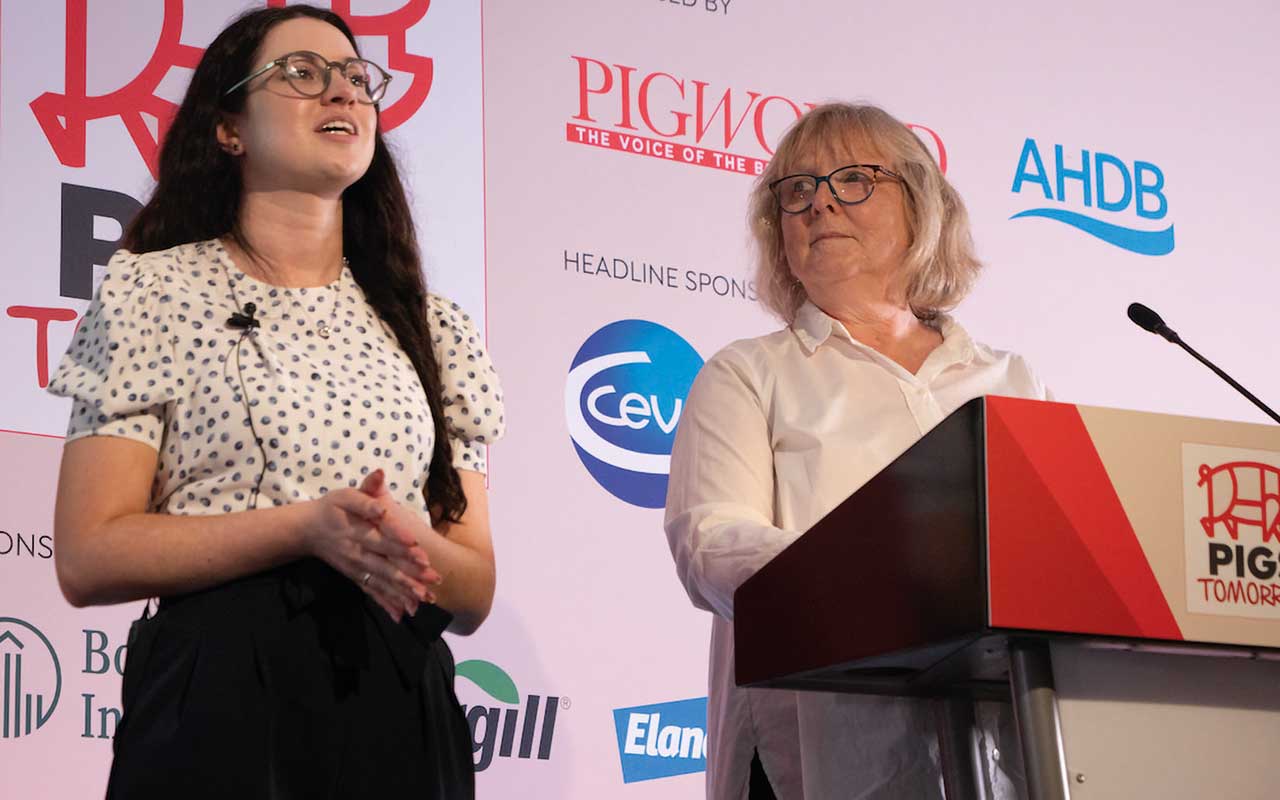There was an indisputably upbeat tone to the 2025 Pigs Tomorrow conference, with lots to be optimistic about, among the challenges, when it comes to the future of the UK pig sector.
The UK pig sector is in as strong a position as it has been for a long time, with confidence returning to a production base that was feeling battered last time we met, and great potential to grow.
That was the clear message from the Pigs Tomorrow conference, albeit against a backdrop of global uncertainty, troubles for the European pig sector and numerous challenges at home. These include the national biosecurity threat, the shift away from conventional farrowing crates, the complexity of environmental requirements, government agricultural policy, labour shortages, animal rights activity and more.
Nonetheless, the general feeling of positivity was evident from conversations with producers throughout the two days and feedback from exhibitors highlighting the extent to which producers are looking to invest and move their businesses forward.
It was also a consistent theme on the main platform. Opening proceedings with a comprehensive global round-up, Rupert Claxton, Gira’s meat and livestock director, said: “I’m far more positive about the UK pig industry than I have been for probably a decade. It is in a really strong position.
“Consolidation continues and that’s maybe bad luck, if you are squeezed out, but it is giving us a real future and momentum to take us into the next decade. That investment at a retail and farm level is coming back in.”
The confidence stems largely from two good years of relatively high prices and manageable costs that have ensured a return to profitability, after the crisis removed a big chunk of the production base.
During a panel session, Sofina Foods Europe’s Mark Haighton said it also stems from a longer-term approach being taken by the supply chain, describing the Sainsbury’s 10-year contract, as ‘previously unheard of’.
“We are in a relatively strong position compared with a couple of years ago. Retailers appear to be aligning behind British pig production and getting behind longer-term supply arrangements,” he said.
Investing in British
Highlighting this, Pilgrim’s Europe agriculture director, Fabio Brancher explained how his company is ‘investing in the future of the British pig industry’. He said the company currently has 55,000 sows, mainly outdoors, and about 285,000 growing spaces and 145 pig farming ‘partners’ working for it.
“We are not self-sufficient in Red Tractor pork. We are buying a lot of these pigs from the market. Only 5% comes from our partners, but we are increasing day by day.”
He outlined Pilgrim’s new package that aims to establish long-term partnerships with farmers to secure its future supplies of pigs, including the provision of 20-year farmer contracts for new builds.
The offering includes a commitment to farmers making a profit throughout the contract. For the new sheds, farmers will receive up to £15 per animal per batch over the next 20 years, plus a monthly management fee and bonuses for achieving targets at the end of the batch.
Mr Brancher said Pilgrim’s would like to increase the number of pigs it processes in the UK, but acknowledged that it was becoming harder to find new farming partners. “So, we need to do something differently to attract more farmers,” he said.
A new cooperative
This was followed by a presentation by Andy McGowan, joint general manager of newly formed United Pig Cooperative (UPC), bringing together Thames Valley Cambac, Scottish Pig Producers and Scotlean.
He explained how UPC would support its independent member base. “It is still about moving pigs off the farms as efficiently as possible and getting the best price we can. That doesn’t change,” he said. “But there is a lot more we can do.”
He said a priority for UPC, which is advertising for a new managing director, is to make better use of the vast quantity of data collected from pig farms to benefit both producers and customers.
UPC is aiming to help farmers measure and improve their carbon footprint, and can help them prepare for farm assurance inspections to help boost compliance.
It also has various initiatives to help maintain and improve pig health, including using health scheme data and Biocheck benchmarking for biosecurity data.
He said organisations like UPC could use their scale to ensure better traceability in the event of a serious disease outbreak, suggesting the industry should not be relying on the ‘underfunded’ APHA for this service.
Similarly, he questioned whether UPC could help lead the innovation work to modernise the meat inspection process, which he suggested was not operating effectively for either industry or consumers.
He concluded that, while there is a great deal that cooperatives can do to support farmer members at all times, they are particularly valuable when times are difficult.
Supply chain relations
Kicking off a Q&A session on the current state and resilience of the UK pork supply chain, he added: “I think the outlook is pretty positive. Processing capacity has adjusted to fit the volume of pigs we can produce.
“We are in a position where the market is very balanced and there is decent demand, and the current chaos in the world might actually give us a benefit. The feed price is lower, so there are reasons to be cheerful.”
John Powell, Defra’s head of the agriculture sectors team, gave a comprehensive summary of the new Fair Dealing Obligations legislation, which was welcomed by the rest of the panel, including NPA chairman Rob Mutimer (see p14).
Mr Mutimer also welcomed the recent introduction of new cost-of-production-based long-term contracts from the likes of Sainsbury’s and Tesco. He said the market has stabilised since the ‘mass exodus’ caused by the crisis.
“There are more contracts out there that offer us greater long-term stability, with elements of cost of production in there. As a mixed farming businesses, we used the basic payment to get us through the last crisis, but it has gone, so a different mindset is needed. Everyone has to be more commercially minded,” he said.
Mr McGowan added: “The retailers had empty shelves through the Ukraine war and it didn’t go unnoticed by the top people in those organisations. This is their attempt to solve it, and we should look on it as a positive, but go in with our eyes open because we learned some harsh lessons a few years ago.
“Processors are in a better place and they are doing it for the right reasons, but we need to make sure the contracts are designed correctly.”
Making the best of Brand Britain

Championing British pork and helping consumers find British produce was discussed in an engaging session on ‘Brand Britain’.
The AHDB pair of Grace Randall, lead retail insight manager, and Fiona Clayton, senior retail account manager, discussed how their work has been aiding shoppers.
Through data and evidence, Mr Randall explained how they’ve helped shape marketing campaigns, government policy and retail space that all lead to improved consumer perceptions of pork.
Key to all of this is understanding how we buy food. Where do we get inspiration from when meal planning? How are we guided when we’re in store?
AHDB’s research literally goes as far as the inside of the kitchen cupboard to find out how consumers shop and, coupled with information from the likes of market research companies Kantar and Nielsen, forms great insight into behaviours.
Evidence suggests there is still work to be done, as the importance of British drops at point of purchase, with price, taste and ease of cooking outranking it.
But it’s reassuring to know that many of the leading supermarkets have committed to sourcing 100% of all fresh pork from Britain, Ms Randall said.
Marketing success
A new AHDB marketing campaign, ‘This is British Pork. But not as you know it’, which ran across broadcast channels in February, put the ‘British’ label at the forefront of the messaging.
Add to that the fact that traditional meals like chops or a roast still dominate meals using primary cuts, and more than 1.8bn ham sandwiches were eaten last year (Kantar).
Improving the vibrancy of the meat aisles, which were once thought of as boring and uninspiring, and using strong foodie imagery on packaging have had a positive effect on how British pork is viewed in store.
The aim is for shopping baskets to better align with the government’s Eatwell Guide. Already, we have seen that those containing primary pork have higher units of plant-rich food items than other meats, Ms Clayton added.




